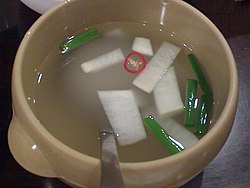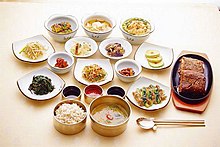 Dongchimi served as banchan | |
| Type | Kimchi |
|---|---|
| Place of origin | Korea |
| Serving temperature | Cold |
| Main ingredients | Korean radish, napa cabbage, scallions, green chilli, ginger, pear |
| Dongchimi | |
| Hangul | 동치미 |
|---|---|
| Hanja | 冬치미 |
| Revised Romanization | dongchimi |
| McCune–Reischauer | tongchi'mi |
Dongchimi is a variety of kimchi consisting of Korean radish, napa cabbage, scallions, pickled green chilli, ginger, Korean pear and watery brine in Korean cuisine. As the name dong (hangul: 동; hanja: 冬; literally "winter") and chimi (hangul: 치미, an ancient term for kimchi), suggests, this kimchi is traditionally consumed during the winter season.[1]
Dongchimi is fermented like other varieties of kimchi, but its maturing period is relatively short (2–3 days). Although it can be made at any time of the year, it is usually made during the gimjang season. The northern regions consisting of Hamgyeong-do and Pyeongan-do in North Korea are particularly famous for their dongchimi.[2]
The clear and clean taste of the watery dongchimi is used as a soup for making dongchimi guksu (동치미국수 cold noodle soup made with dongchimi) and naengmyeon, or served with tteok or steamed sweet potatoes to balance out the rich flavors.[3]
